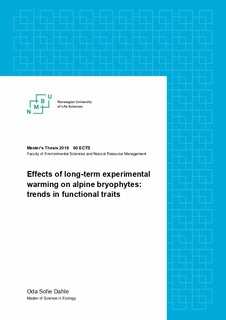| dc.description.abstract | Functional traits are becoming increasingly important tools to evaluate plant community response to climate change. Artificial warming treatments can shift community-level trait values as a consequence of intraspecific variation, species turnover and their covariation. These warming studies on vascular plants suggest that the shift is mostly caused by species turnover, while studies on lichens suggest that much of the shift in traits is explained by intraspecific variation. There is limited knowledge about how bryophytes respond under simulated warming and to what degree the response is a consequence of intraspecific variation. In contrast to vascular plants, they should respond strongly to their external environment, as they lack the physiological structures to maintain homeostasis. In order to evaluate the significance of intraspecific variation and species turnover for bryophytes, I assessed bryophyte cover and measured the functional traits: carbon concentration (C), nitrogen concentration (N), water holding capacity (WHC), shoot length, biomass, area and some of their ratios in warmed plots simulating climate change and control plots at Sanddalsnuten, Finse.
I found some support for my first hypothesis; shorter, lower biomass shoots with lower WHC in the warmed plots suggests higher competition from vascular plants in the warmed plots. My second hypothesis that most of the explained variation seen between plots would be accounted for by species turnover, was mostly supported. I found the growth form of the warmed bryophytes to shift towards growth forms associated with the lowland, giving support for my last hypothesis. My work in this thesis underline the importance of including the trait variation of non-vascular primary producers like bryophytes when predicting future environmental changes. To get a more complete picture environment change as a consequence of climate change phenomena, inclusion of species turnover as well as the within-species variation are paramount. | nb_NO |

